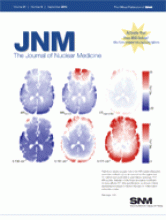TO THE EDITOR: We read with interest the article by Taylor et al. on combined CT colonography and PET using a nonlaxative preparation (1). It is nice to see others pursuing further this technically feasible examination on which we originally reported (2). There are a few points of interest that have prompted this letter: First, we found it remarkable that the mean volume of CO2 insufflated was 3.1 L with a maximum of 4.1 L! Our own examinations averaged 33 L with a maximum of 65 L and had no reported side effects. Our mean room time was longer, however (77 min). Unlike their technique, we did not systematically turn down the CO2 pressure to 15 mm Hg after achieving patient tolerance because we believed that reabsorption of CO2 is so rapid that reducing the pressure would reduce colonic distension. It is hard to understand the difference in volumes between our 2 studies, and we wonder if the authors could comment. Second, as the authors correctly state, the increased specificity supposedly offered by PET assumes that the lack of focal 18F-FDG uptake always indicates lack of a true lesion (which the authors disproved, like others, in their own paper). Therefore, in this study with few lesions overall, the true meaning of this increased specificity seems to remain a bit questionable. Third, we wonder if the reported level and frequency of discomfort at colonoscopy might be attributable to the type of sedation administered (midazolam and pethidine). Types of sedation vary worldwide and may not even be used in some centers (3,4). In the United States, propofol (Diprivan; AstraZeneca), a deep-sedative hypnotic, is being used more often. Patients seem to achieve greater comfort and less recollection of pain. One wonders if this would have changed the balance of preference. Fourth, it is hard to extrapolate Figure 7 from results in Figure 6. It seems that about the same number of patients rates each examination “well” or “fairly well” and yet most chose PET/CT colonography as more acceptable and as more desirable to undergo again. One wonders if there was some sort of recall bias or whether the entire equation comes down to the colonic preparation involved rather than the actual test itself. Do the authors have any sense for what part the preparation played in the rating? That is, is there a statistical way to separate out this component? Also 13 patients did not even return the questionnaire. Could they all have been utterly disgusted with both examinations? Fifth and finally, one disadvantage to which the authors allude but do not address is that if this minimal-preparation technique were to be implemented, patients who have a positive finding would have to undergo a full preparation for colonoscopy. In our study, patients went directly to colonoscopy. However, if in fact the negative predictive value of such a test in this population were shown to be high, patients could avoid a full preparation and a colonoscopy altogether—the obvious advantage.
- © 2010 by Society of Nuclear Medicine







